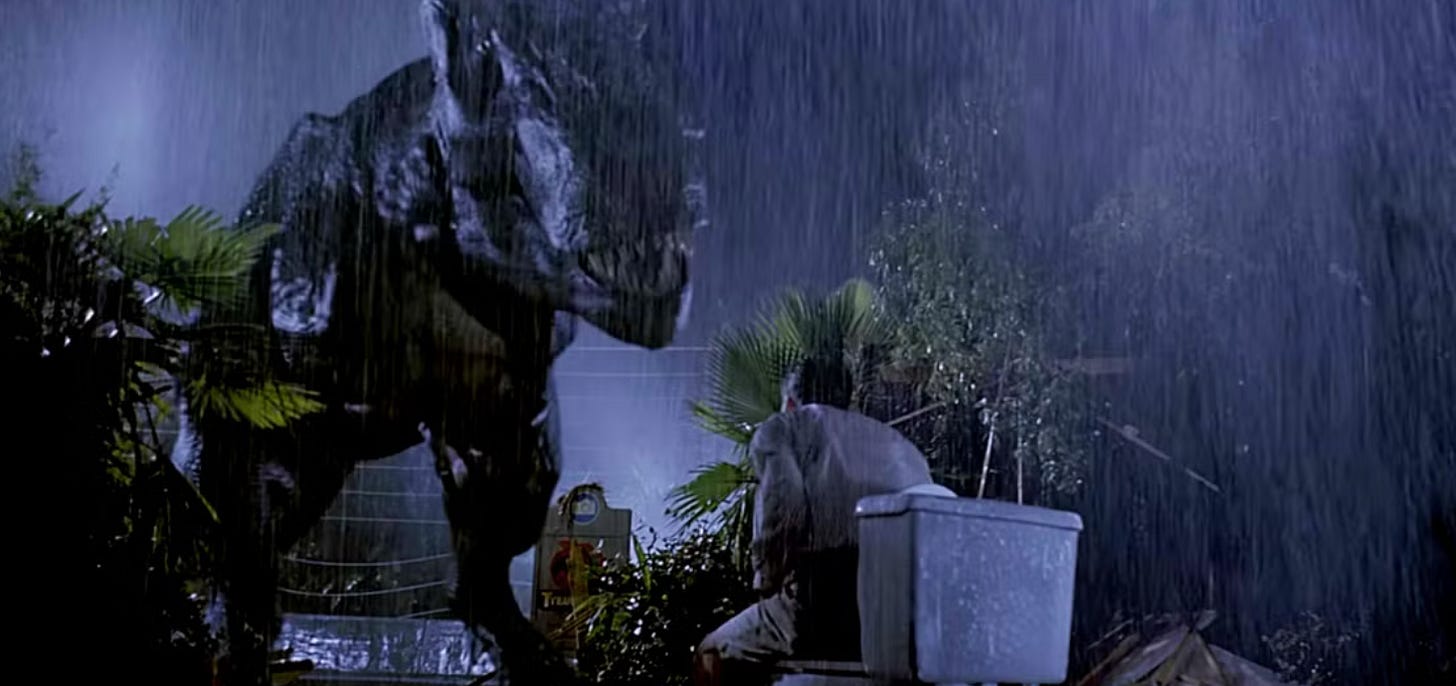The Wicker Man comes to Canvey Wick
Why I invariably get weirded out when I walk the Essex coastline
This is the second in an occasional series on rewilded places out east.
More often than not, I’ll get the crap spooked out of me when I head out east from London on a coastal walk.
That was literally the case on my last visit to Orford Ness, off the Suffolk coast. It used to be the British equivalent of Area 51, the air base in Nevada that never appeared on a map.
Okay, so you’ve de-commissioned a scary weapons establishment that’s been sort of top secret for nearly a century. The Ministry of Defence remove incriminating evidence from buildings with dodgy names like ‘The Black Beacon’ and ‘The Ionospheric Research Station’ and you leave a toilet cistern hiding in plain sight?
Had I stumbled upon a set from Jurassic Park? Like the scene where the T-Rex plucks the roof off the bathroom where the cowardly lawyer had hidden after abandoning the children?
A couple of months later I took the train out of Liverpool Street to walk from Manningtree to Harwich.
It’s one of my favourites, taking in a variety of estuarine landscapes. Woods with nightingales and turtle doves, banks on the Stour hollowed out by nesting sand martins and swallows darting into the barns where they are nesting.
However on this occasion I was brought up short by this sign blocking the footpath.
It looked kind of sturdy and permanent but why were my name and initials on it? It was only the second time I had done that walk but I must have done something really bad first time round to be called out like that.
Later that autumn I was quietly minding my own business, walking up the Grays Inn Road to pick up my new steed from Condor Cycles when I found this laser printed laminate cable-tied to a lamp post.
It turned out that the QR code took you to something called the Pub Club Finder. I am not sure whether they were just trying to recruit people called Mark in this eye-catching promo. The link apologised for appearing to persecute me and my namesakes. Well, that’s ok then.
My sense of paranoia growing I decided to take myself off to the remotest place I could think of. Or at least the remotest within a one hour train ride from London.
I plumped for Canvey Island, a real life island tethered to the Essex mainland by a road bridge 30 metres long. Wikipedia will tell you that it is a place shaped by its low-lying landscape and the petrochemical industry. In my memory, it was all about Doctor Feelgood, the ultimate pub rock band and some would say a precursor of what of what became punk in the 70s.
If ever a band’s music was shaped by the landscape it was Doctor Feelgood. The band members were all brought up within a few streets of each other on Canvey.
In the 20th century the petrochemical industry piled into the western side of the island attracted by the proximity to London and the Thames and the lack of people in case it all blew up in their faces, literally. Companies like Texaco, Occidental and British Gas built storage facilities for gas and oil which at their peak totalled over a half a million tonnes.
That was until a failed IRA bomb attack in 1979 led to the realisation that there was a real danger that the whole island could go up in flames along with Southend on the mainland. At that point permissions were pulled and plans scaled back.
Julian Temple’s 2009 documentary on the band was called Oil City Confidential for that reason. The Feelgoods’ legendary guitarist, Wilko Johnson, described by Peter Bradshaw, the Guardian film critic as “a 100-1 shot for the title of Greatest Living Englishman” at least until his death in 2022, thought the island stood comparison with the Mississippi Delta. Lines like “see you in the morning down by the jetty” where the “big ships go gliding by” pay homage to the band’s very own ‘Thames Delta’. It’s where Wilko imagined legendary blues man Muddy Waters cutting his teeth in the early decades of the 20th century if he had been born on the other side of the Atlantic.
One particular abandoned site owned by Occidental had a half-built oil refinery, storage tanks and an unused mile-long jetty that ate up over £10 million in 1970s pounds sterling. And you know the story by now when it comes to rewilding. The disused and undisturbed site quickly attracted a plethora of wildlife and after a bit of a clean-up, it was reopened as Canvey Wick nature reserve.
Actually, ‘plethora’ is a bit of an understatement.
The reserve is said to have “more biodiversity per square foot than any other site in the UK” according to Natural England. Over 1,300 species of invertebrates have been recorded here, including many endangered insects with fantastical names like the pantaloon bee, the five-banded weevil hunting wasp along with hundreds of orchids found nowhere else in the UK. And that’s because of, not despite the thin dredged-up soil on the reserve.
The fact that this place was called a ‘Wick’ also intrigued me. When we were young, my father often said to us when we were being annoying: “You’re getting on my wick”. I didn’t understand at that age how part of a candle could stand in as a metaphor for irritation.
It was only later I learned that he was turning to Cockney rhyming slang. This was an abbreviation for ‘Hampton Wick’ a suburb of London on the side of the Thames, a polite rhyming stand-in for the word ‘prick’.
The island had been a haven for a substantial East End diaspora since the end of World War Two but that was not the reason the reserve was christened Canvey Wick. On our eastern seaboard the word ‘Wick’ has Viking origins in the Old Norse language and means a ‘bay’ or ‘inlet’. Coincidentally a ‘Wick” had already cropped up in our newly rewilded lives. Over successive lockdowns we had come to know and love Fingringhoe Wick further up the coast, another de-industrialised site bursting with life now.
This year c2c, the franchise-holder for this stretch of coastline unveiled a carriage that goes by the splendid name of the ‘Wilko Express’ after the co-founder of Doctor Feelgood.
So as you can imagine I turned up at Fenchurch Street station next to the Tower of London full of expectation that I too would ride with the ghost of one of my guitar heroes. Alas, I was transported to Benfleet, the last mainland station across from Canvey, in smart but very much regular rolling stock.
The mundanity continued unabated with a short bus ride to the car park of an enormous branch of the supermarket Morrisons. But then a 10 minute walk across bare wasteland from there was enough to set my weirdness radar off.
I had by now visited enough rewilded paradises in the shadow of nuclear bunkers, secret weapons institutes and train depots for one behind the car park of an out-of-town superstore not to surprise me. In keeping with the brownfield vibe, this kingfisher sculpture repurposed from scrap metal marked the start of the reserve.
But note the scarecrow photobombing the dragonfly here. Was this another sign of impending weirdness?
Five minutes further, on what was planned to be the one of the few dockside unloading points to be built by Occidental, a procession of container ships and cruise liners was lumbering up the Thames just a few hundred yards away towering over the refineries.
Everything was already a bit out of kilter by the time I started to stride out along the sea wall heading back north towards the mainland when that Essex weirdness struck again.
What was going on? Was this evidence of satanic rites on Canvey Island?
The Essex coastline with its mists and desolation had been becoming a byword for sorcery and the supernatural in books like Sarah Perry’s Essex Serpent and The Manningtree Witches by A.K. Blakemore. But it was something else that flashed into my mind at that moment. The Wicker Man.
Although the cult classic film was set not in Essex but the Western Isles of Scotland, had I been lured here unwittingly for nefarious ends by the promise of boundless biodiversity, like the film’s Sergeant Howie played with magnificent uptightness by Edward Woodward?
Would Christopher Lee loom out of the Thames like Lord Summerisle and encase me in a wicker effigy?
There is a whole level of weirdness that definitely has me hooked on the Thames Estuary and its environs. And in many ways the wildlife is the cherry on the top of that cake. So whilst the Wicks, both Canvey and Fingringhoe, are nailed-on guarantees for me to visit for nightingales in May and June, it is the post-industrial tracery and uncanniness of both that fill me with joy.
Richard Jeffries’ late 19th century After London is the first novel to ask the ‘what if’ questions of our capital in the event of the apocalypse. With society’s collapse how do we imagine a London reconquered by nature? Written in Surbiton, now a genteel London suburb, then a Victorian liminal space between town and countryside, Jeffries paints a picture of the low-lying areas reverting to marsh-land:
‘Sometimes, after great rains, the flood cracked and split the bridges of solid stone which the ancients had built. These and the iron bridges likewise were overthrown, and presently quite disappeared, for the very foundations were covered with the sand and gravel silted up’
The Dutch settlers invited to Canvey Island during the 17th century did what the Dutch did best here and across East Anglia; they built dykes and ditches to keep the water out. That worked out OK until the night of 1st February 1953 when a storm surge coming down from the North Sea killed 53 islanders.
Jeffries could be describing from the high ground of the late Victorian era what will happen to Canvey Island and its rigs and holding tanks with rising sea levels. It may be one of the first places that gets abandoned and handed back to the sea when the walls are breached by the next big storm surge, the next 1953.
But when I beat its western bounds, the uncanniness of the island make me feel like it’s already gone. Once I’m two minutes from the car park and the dog walkers, I’ve never seen another soul there. But the cacophony of bird life, the reed warblers and cuckoos calling in spring, the plaintiff cries of the curlew and the redshank in winter, will still be heard and probably redoubled once humankind is out of the way.
I hope it’s not too morbid to say this anticipation fills me with a quiet joy.











Yes Robert, they been displaced by our children's generation moving in en masse to Hackney. Canvey might be one of the last cheap places to live in the south of England.
I'm sitting in a Calgary park reading this and I feel distinctly unsettled now. Brilliant!